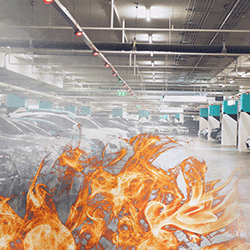
Underground parkings are an integral part of modern urban infrastructure, offering a safe and convenient space for vehicle parking. However, due to their enclosed location and limited natural ventilation, these spaces can pose significant risks in case of fire, especially regarding the accumulation of smoke and toxic gases. To mitigate these dangers, the implementation of highly effective and efficient ventilation control systems is required.
Ventilation control systems play a fundamental role in protecting the safety and well-being of users in underground parkings. When designing and implementing these systems, it is crucial to consider factors such as the size of the space, indoor air quality, regulatory compliance, and the integration of detection and ventilation technologies. By doing so, we can ensure a safe and healthy environment for all users of these facilities.
Let's examine the essential components and best practices in the design of ventilation control systems for underground parkings, addressing specific safety and regulatory compliance needs.
Casals Ventilación provides the necessary fans, whether they are extraction, supply, or jet fans certified F400, as well as intelligent control systems to carry out smoke extraction and reduction of pollutants in a parking facility in case of fire.
A critical aspect in the design of ventilation control systems is the consideration of the size and layout of the underground parking. Starting from a surface area of 100 m², it is essential to carefully plan the distribution of intake and exhaust openings to ensure adequate ventilation throughout the space. Air intake openings should be strategically located to allow the entry of fresh air from the outside, while exhaust openings should be placed in areas that facilitate the rapid and effective evacuation of smoke and gases.
The design and installation of ventilation control systems in underground parkings must comply with the regulations established in the Technical Building Code in Spain or equivalent regulations that address building construction and safety in each country. These regulations focus on ensuring the safety of occupants and protection against fires, including indoor air quality and early detection of pollutant gases. It is essential for ventilation systems to directly communicate with the exterior to facilitate the exchange of fresh and contaminated air.
Detection and control of toxic gases
To detect and control the accumulation of toxic gases, such as carbon monoxide, CO detection systems must be installed on each level of the underground parking. These systems provide early warning in case of dangerous CO levels, allowing for a rapid response and activation of the corresponding ventilation system.
In the event of a fire, the ventilation control system plays a crucial role in improving visibility in the fire zone by clearing smoke, providing fresh air to reduce the toxicity of the environment and lowering the ambient temperature of the space where the fire has occurred. By expelling smoke and introducing fresh air, these systems help firefighters access the facility where the fire has occurred and allow occupants and potential victims to be safely evacuated.
Integration of mechanical and natural ventilation
An effective strategy to optimize the efficiency of ventilation control systems is to integrate both mechanical and natural ventilation. Mechanical ventilation, through duct networks and fans, provides a constant flow of fresh air and facilitates smoke extraction in case of fire. On the other hand, natural ventilation harnesses natural air currents and ventilation openings to complement the mechanical system, improving air circulation and reducing dependence on electrical energy.
Stagnation and carbon monoxide detection
The stagnation of carbon monoxide on each level of the underground parking is a critical indicator of the effectiveness of the ventilation system. Early detection of CO is essential to prevent occupants' exposure to dangerous levels of this deadly gas. Therefore, measures must be implemented to ensure adequate coverage of CO detectors throughout the space, as well as regular maintenance procedures to ensure optimal operation.
In conclusion, advanced ventilation control systems play a vital role in ensuring the safety of underground parking users in case of fire. By carefully designing and implementing these systems, and by complying with regulatory requirements, we can create a secure and healthy environment for all who utilize these facilities.
Casals Ventilación has an intelligent control panel for fire safety in underground parking lots: ParkGuard. Its objective is to control the concentration of pollutants (such as smoke and CO) and activate the ventilation system accordingly.